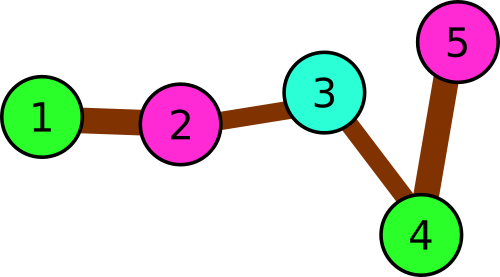C. Andryusha and Colored Balloons--bfs
来源:互联网 发布:漫步者s2000mkii 知乎 编辑:程序博客网 时间:2024/05/17 00:15
Andryusha goes through a park each day. The squares and paths between them look boring to Andryusha, so he decided to decorate them.
The park consists of n squares connected with (n - 1) bidirectional paths in such a way that any square is reachable from any other using these paths. Andryusha decided to hang a colored balloon at each of the squares. The baloons' colors are described by positive integers, starting from 1. In order to make the park varicolored, Andryusha wants to choose the colors in a special way. More precisely, he wants to use such colors that if a, b and c are distinct squares that a and b have a direct path between them, and b and c have a direct path between them, then balloon colors on these three squares are distinct.
Andryusha wants to use as little different colors as possible. Help him to choose the colors!
The first line contains single integer n (3 ≤ n ≤ 2·105) — the number of squares in the park.
Each of the next (n - 1) lines contains two integers x and y (1 ≤ x, y ≤ n) — the indices of two squares directly connected by a path.
It is guaranteed that any square is reachable from any other using the paths.
In the first line print single integer k — the minimum number of colors Andryusha has to use.
In the second line print n integers, the i-th of them should be equal to the balloon color on the i-th square. Each of these numbers should be within range from 1 to k.
32 31 3
31 3 2
52 35 34 31 3
51 3 2 5 4
52 13 24 35 4
31 2 3 1 2
In the first sample the park consists of three squares: 1 → 3 → 2. Thus, the balloon colors have to be distinct.
 Illustration for the first sample.
Illustration for the first sample.In the second example there are following triples of consequently connected squares:
- 1 → 3 → 2
- 1 → 3 → 4
- 1 → 3 → 5
- 2 → 3 → 4
- 2 → 3 → 5
- 4 → 3 → 5
 Illustration for the second sample.
Illustration for the second sample.In the third example there are following triples:
- 1 → 2 → 3
- 2 → 3 → 4
- 3 → 4 → 5
 Illustration for the third sample.
Illustration for the third sample.题目链接:http://codeforces.com/contest/782/problem/C
题目的意思是让你染色,相邻的三个不可有相同的颜色,那么我们考虑记录每个节点的父节点,给这个节点的子节点染色,用vector排一下序即可。
我手贱排了一下序,因为他说每个节点要用它自己编号的颜色,我就手贱了,但是为什么不用排序呢?
代码:
#include <cstdio>#include <cstring>#include <iostream>#include <queue>#include <algorithm>#include <vector>using namespace std;const int maxn=500000;vector<int>G[maxn];struct node1{ int color; int p1; int p2;}xin[maxn];void Init(){ for(int i=0;i<=400000;i++){ xin[i].color=-1; xin[i].p1=0; xin[i].p2=0; }}int mix;void bfs(int s){ xin[s].color=1; queue<int>Q; Q.push(s); while(!Q.empty()){ int t=Q.front(); Q.pop(); int kk=1; for(int i=0;i<(int)G[t].size();i++){ int v=G[t][i]; if(xin[v].color!=-1) continue; xin[v].p1=t; xin[v].p2=xin[t].p1; while(kk){ if(xin[t].color==kk||xin[xin[t].p1].color==kk){ kk++; mix=max(kk,mix); } else{ mix=max(kk,mix); xin[v].color=kk++; break; } } Q.push(v); } }}int main(){ int n; mix=0; Init(); scanf("%d",&n); for(int i=0;i<n-1;i++){ int x,y; scanf("%d%d",&x,&y); G[x].push_back(y); G[y].push_back(x); } //for(int i=1;i<=n;i++){//就在这,我手贱的拍了一下序,注释掉这三行就对了 // sort(G[i].begin(),G[i].end()); // } bfs(1); //for(int i=1;i<=n;i++){ // printf("%d %d %d\n",i,xin[i].p1,xin[i].p2); //} cout<<mix<<endl; for(int i=1;i<=n;i++){ printf(i==1?"%d":" %d",xin[i].color); } cout<<endl; return 0;}- C. Andryusha and Colored Balloons--bfs
- C. Andryusha and Colored Balloons
- C. Andryusha and Colored Balloons
- C. Andryusha and Colored Balloons
- Codeforces 782C Andryusha and Colored Balloons(BFS)
- Andryusha and Colored Balloons
- 【codeforces 782C】Andryusha and Colored Balloons
- codeforces 782c Andryusha and Colored Balloons
- Codeforces 780C-Andryusha and Colored Balloons
- cf 782c Andryusha and Colored Balloons
- codeforces781A Andryusha and Colored Balloons
- Codeforces Andryusha and Colored Balloons
- Codeforces Round #403 (Div. 2) C. Andryusha and Colored Balloons
- Codeforces 782C Andryusha and Colored Balloons dfs
- Codeforces Round #403 C. Andryusha and Colored Balloons(DFS)
- Codeforces Round #403 div2 C. Andryusha and Colored Balloons
- Codeforces Round #403 (Div. 2) C. Andryusha and Colored Balloons
- codeforces 782C Andryusha and Colored Balloons【构造】
- 杨辉三角(生成器)
- redis数据迁移
- 【Hibernate】关系映射
- 解决AndroidStudio的 File Explorer不显示目录树的问题
- js判断上传图片大小限制300k
- C. Andryusha and Colored Balloons--bfs
- Linux设备驱动开发详解——读书笔记
- c8051f320实现HID类(usb keyboard, usb mouse, usb joystick)
- elasticsearch
- 邻接表的创建与输出(C语言)
- BZOJ 1013 [JSOI2008] 球形空间产生器sphere
- mobile抓包分析方法记录
- Java的运算符-取整,取绝对值,取余数
- android实现始终显示overflow菜单的方法


